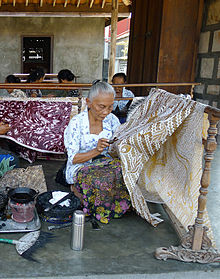
Back Batik Afrikaans باتيك Arabic Batik AST Batika Azerbaijani Батик Bashkir Batik BAN Батык Byelorussian Батик Bulgarian Bàtik Catalan Batikování Czech
 Batik from Surakarta in Central Java province in Indonesia; before 1997 | |
| Type | Art fabric |
|---|---|
| Material | Cambrics, silk, cotton |
| Place of origin | Indonesia[1][2][3] |
| Indonesian Batik | |
|---|---|
 | |
| Country | Indonesia |
| Domains | Traditional craftsmanship, oral traditions and expressions, social practices, rituals and festive events |
| Reference | 00170 |
| Region | Asia and the Pacific |
| Inscription history | |
| Inscription | 2009 (4th session) |
| List | Representative |
| Written batik (batik tulis) and stamped batik (batik cap) | |
| Education and training in Indonesian Batik[a] | |
|---|---|
 | |
| Country | Indonesia |
| Domains | Traditional craftsmanship, oral traditions and expressions, social practices, rituals and festive events |
| Reference | 00318 |
| Region | Asia and the Pacific |
| Inscription history | |
| Inscription | 2009 (4th session) |
| List | Good Safeguarding Practices |
Batik[b] is an Indonesian technique of wax-resist dyeing applied to the whole cloth.[1][4][2][5][6] This technique originated from the island of Java, Indonesia.[3] Batik is made either by drawing dots and lines of wax with a spouted tool called a canting,[c] or by printing the wax with a copper stamp called a cap.[d][7] The applied wax resists dyes and therefore allows the artisan to colour selectively by soaking the cloth in one colour, removing the wax with boiling water, and repeating if multiple colours are desired.[3]
Indonesian coastal batik (batik pesisir) made in the island of Java has a history of acculturation, a mixture of native and foreign cultures.[8] It is a newer model compared to inland batik, and it uses more colors, though the patterns are less intricate. This is because inland batik used to be made by select experts living in palace areas, while coastal batik can be made by anyone.[citation needed]
Batik is very important to Indonesians and many people wear it to formal or casual events. Batik is commonly used by Indonesians in various rituals, ceremonies, traditions, celebrations, and even in daily uses.[9]
On October 2, 2009, UNESCO officially recognized the batik—written batik (batik tulis) and stamped batik (batik cap)—as a Masterpiece of Oral and Intangible Heritage of Humanity from Indonesia, and encouraged the Indonesian people and the Indonesian government to safeguard, transmit, promote, and develop the craftsmanship of batik.[1] Since then, Indonesia celebrates "the National Batik Day" (Indonesian: Hari Batik Nasional) annually on October 2. Nowadays, Indonesians wear batik in honor of this ancient tradition.[9]
In the same year, UNESCO also recognized "Education and training in Indonesian Batik intangible cultural heritage for elementary, junior, senior, vocational school and polytechnic students, in collaboration with the Batik Museum in Pekalongan" as a Masterpiece of Oral and Intangible Heritage of Humanity in the Register of Good Safeguarding Practices List.[10]
- ^ a b c "Indonesia Batik". UNESCO. Archived from the original on 8 December 2020. Retrieved 21 October 2019.
- ^ a b "Batik". Merriam-Webster. Archived from the original on 2 February 2021. Retrieved 2 January 2021.
- ^ a b c "What is Batik?". The Batik Guild. Archived from the original on 13 November 2019. Retrieved 17 July 2017.
- ^ "Batik". Cambridge. Archived from the original on 3 May 2022. Retrieved 2 January 2021.
- ^ Robert Pore (12 February 2017). "A unique style, Hastings artist captures wonder of crane migration". The Independent. Archived from the original on 26 June 2019. Retrieved 17 July 2017.
- ^ Sucheta Rawal (4 October 2016). "The Many Faces of Sustainable Tourism – My Week in Bali". Huffingtonpost. Archived from the original on 17 June 2017. Retrieved 17 July 2017.
- ^ The Jakarta Post Life team. "Batik: a cultural dilemma of infatuation and appreciation". The Jakarta Post. Archived from the original on 5 September 2019. Retrieved 17 July 2017.
- ^ Cite error: The named reference
brwas invoked but never defined (see the help page). - ^ a b Rebecca Shamasundari (7 February 2021). "Celebrating Indonesia's cultural heritage, batik". The ASEAN Post. Archived from the original on 17 April 2021. Retrieved 6 February 2021.
- ^ "Education and training in Indonesian Batik intangible cultural heritage for elementary, junior, senior, vocational school and polytechnic students, in collaboration with the Batik Museum in Pekalongan". UNESCO. Archived from the original on 8 December 2020. Retrieved 5 February 2021.
Cite error: There are <ref group=lower-alpha> tags or {{efn}} templates on this page, but the references will not show without a {{reflist|group=lower-alpha}} template or {{notelist}} template (see the help page).
© MMXXIII Rich X Search. We shall prevail. All rights reserved. Rich X Search